

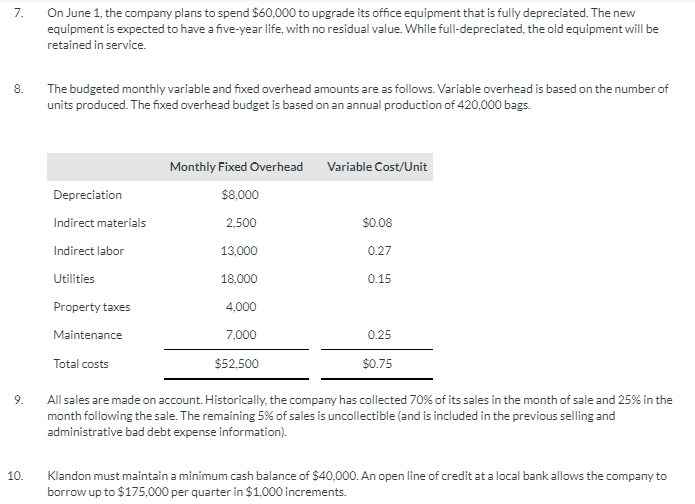

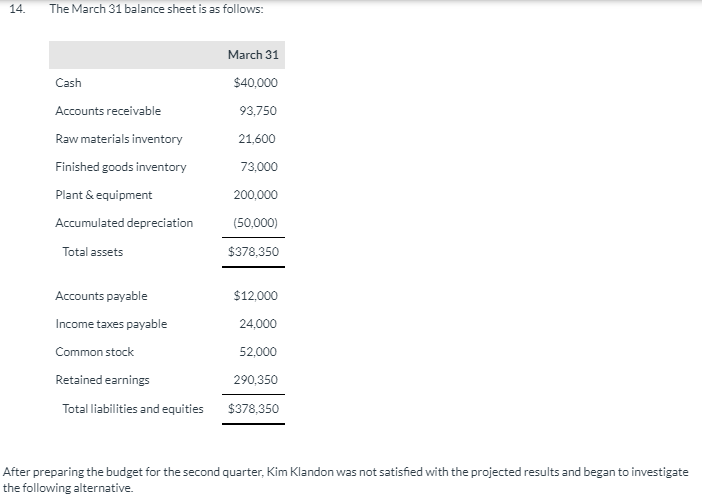
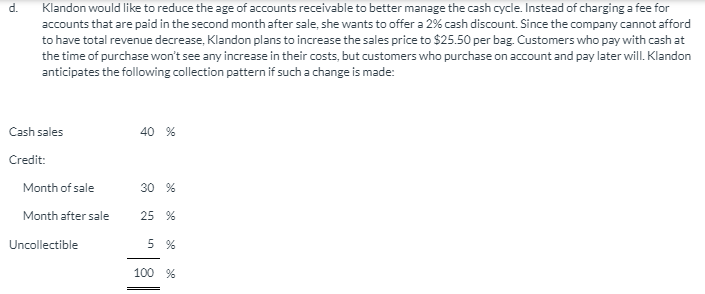
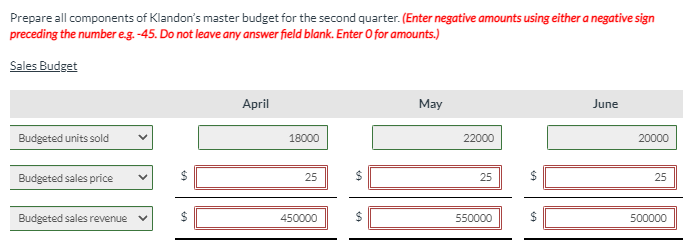

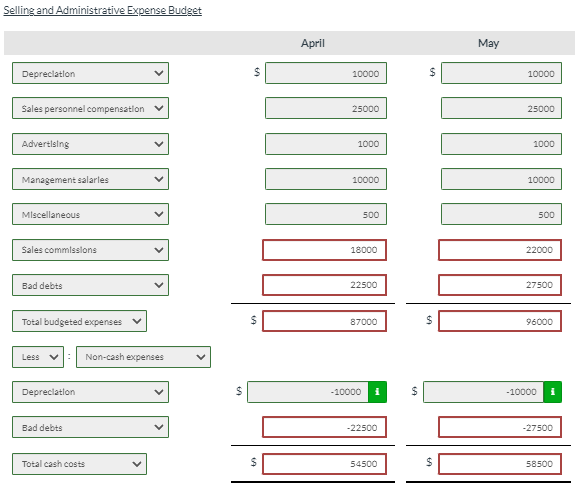

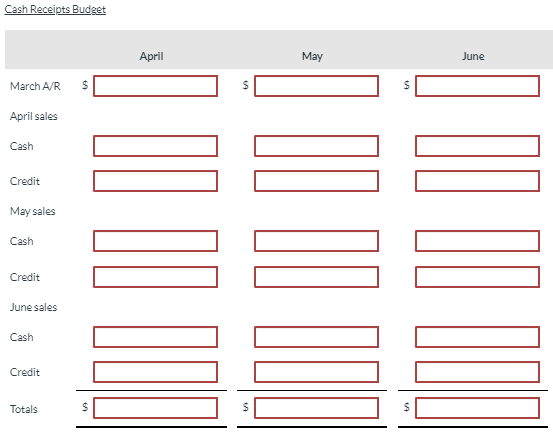
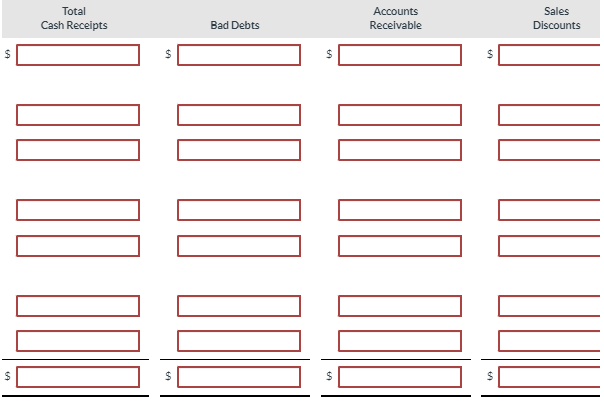
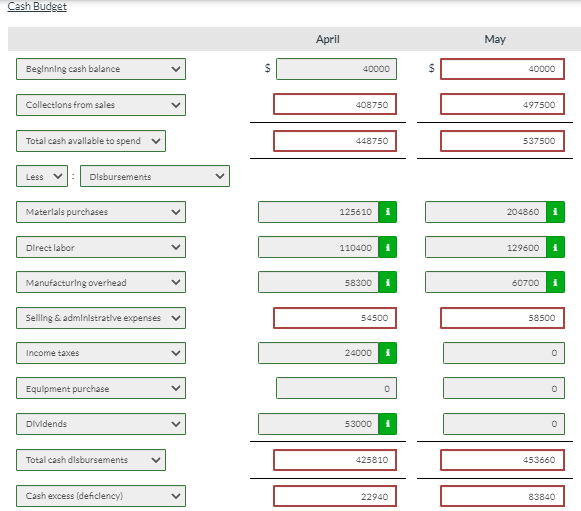



Klandon Company manufactures decorative rocks for aquariums. Kim Klandon is preparing the budget for the quarter ended June 30. She has gathered the following information: 1. Klandon's sales manager reported that the company sold 15,000 bags of rocks in March. He has developed the following sales forecast. The expected sales price is $25 per bag. April May June 18,000 bags 22,000 bags 20,000 bags 24,000 bags 16,000 bags July August 2. Sales personnel receive a 4% commission on every bag of rocks sold. The following monthly fixed selling and administrative expenses are planned for the quarter. However, these amounts do not include the depreciation increase resulting from the budgeted equipment purchase in June (see part 7). Variable Cost/Unit Monthly Fixed Selling and Administrative Costs $10,000 25,000 $1.00 1,000 Depreciation Salaries of sales personnel Advertising Management salaries Miscellaneous Bad debts 10.000 500 Total costs $46,500 $1.00 3. After experiencing difficulty in supplying customers in a timely fashion due to inventory shortages, the company established a policy requiring the ending Finished Goods Inventory to equal 20% of the following month's budgeted sales, in units. On March 31, 4,000 bags were on hand. 4 Eight pounds of direct materials are required to fill each bag of finished rocks. The company wants to have direct materials on hand at the end of each month equal to 10% of the following month's production needs. On March 31, 13,000 pounds of materials were on hand. 5. The direct materials used in production cost $1.25 per pound. Sixty percent of the month's purchases are paid for in the month of purchase; the remaining 40%, in the following month. No discount is available. 6. The standard labor allowed for one bag of rocks is 30 minutes. The current direct labor rate is $12 per hour. 7. On June 1, the company plans to spend $60,000 to upgrade its office equipment that is fully depreciated. The new equipment is expected to have a five-year life, with no residual value. While full-depreciated, the old equipment will be retained in service. 8. The budgeted monthly variable and fixed overhead amounts are as follows. Variable overhead is based on the number of units produced. The fixed overhead budget is based on an annual production of 420,000 bags. Monthly Fixed Overhead Variable Cost/Unit $8,000 2.500 $0.08 0.27 Depreciation Indirect materials Indirect labor Utilities Property taxes Maintenance Total costs 0.15 13,000 18,000 4,000 7,000 0.25 $52,500 $0.75 9. All sales are made on account. Historically, the company has collected 70% of its sales in the month of sale and 25% in the month following the sale. The remaining 5% of sales is uncollectible and is included in the previous selling and administrative bad debt expense information). 10. Klandon must maintain a minimum cash balance of $40,000. An open line of credit at a local bank allows the company to borrow up to $175,000 per quarter in $1,000 increments. 11. All borrowing is done at the beginning of the month, and all repayments are made at the end of a month in $1,000 increments. Accrued interest is paid any time a principal payment is made. The interest rate is 12% per year. 12. A quarterly dividend of $53,000 will be declared and paid in April. 13. Income taxes payable for the first quarter will be paid on April 15. Klandon's tax rate is 30%. 14. The March 31 balance sheet is as follows: March 31 Cash $40,000 93,750 21,600 73,000 Accounts receivable Raw materials inventory Finished goods inventory Plant & equipment Accumulated depreciation Total assets 200,000 (50,000) $378,350 Accounts payable $12,000 24,000 Income taxes payable Common stock 52,000 290,350 Retained earnings Total liabilities and equities $378,350 After preparing the budget for the second quarter, Kim Klandon was not satisfied with the projected results and began to investigate the following alternative. d. Klandon would like to reduce the age of accounts receivable to better manage the cash cycle. Instead of charging a fee for accounts that are paid in the second month after sale, she wants to offer a 2% cash discount. Since the company cannot afford to have total revenue decrease, Klandon plans to increase the sales price to $25.50 per bag. Customers who pay with cash at the time of purchase won't see any increase in their costs, but customers who purchase on account and pay later will. Klandon anticipates the following collection pattern if such a change is made: 40 % Cash sales Credit: Month of sale Month after sale Uncollectible 30 % 25 % 5 % 100 % Prepare all components of Klandon's master budget for the second quarter. (Enter negative amounts using either a negative sign preceding the number eg.-45. Do not leave any answer field blank. Enter for amounts.) Sales Budget April May June Budgeted units sold 18000 22000 20000 Budgeted sales price $ 25 $ 25 $ $ 25 Budgeted sales revenue 450000 550000 500000 Quarter 60000 25 $ 1500000 Selling and Administrative Expense Budget April May Depreciation S 10000 S 10000 Sales personnel compensation 25000 25000 Advertising 1000 1000 Management salarles 10000 10000 Miscellaneous 500 500 Sales commissions 18000 22000 Bad debts 22500 27500 Total budgeted expenses 87000 96000 Less V: Non-cash expenses Depreciation - 10000 i $ -10000 i Bad debts -22500 -27500 Total cash costs s 54500 $ 58500 June Quarter $ 10000 $ 30000 25000 75000 1000 3000 10000 30000 500 1500 20000 60000 25000 75000 $ 91500 $ 274500 $ -10000 $ -30000 -25000 -75000 $ 56500 $ 169500 Cash Receipts Budget May June March A/R $ $ $ April sales DIA DO DO LIO DO DO I Lud 00 I ! June sales Cash Credit Totals $ $ Total Cash Receipts Accounts Receivable Sales Discounts Bad Debts $ $ $ $ 100 00 00 III DO DO $ Cash Budget April May Beginning cash balance 40000 40000 Collections from sales 408750 497500 Total cash available to spend 448750 537500 Less Disbursements Materials purchases 125610 204860 1 Direct labor 110400 i 129600 i Manufacturing overhead 58300 60700 Selling & administrative expenses 54500 58500 Income taxes 24000 0 Equipment purchase 0 0 Dividends 53000 0 Total cash disbursements 425810 453660 Cash excess (deficiency 22940 83840 June Quarter 66439 $ 40000 487500 1393750 553939 1433750 211840 542310 124800 i 364800 60100 179100 56500 169500 24000 60000 i 60000 0 53000 513240 1392710 40699 41040 Minimum cash balance 40000 40000 i Cash excess (needed) -17060 43840 Financing Borrowings 17060 Repayments 17060 Interest 341 DADO! DOMIN Total financing 17060 Ending cash balance $ 40000 $ 66439 40000 i 4000 T 6 1040 17060 -17060 -341 $ 40699 | 40699






















